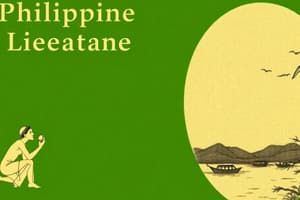Podcast
Questions and Answers
What is the main purpose of prose?
What is the main purpose of prose?
- To tell a story with a moral lesson
- To entertain through dramatic recitation
- To express feelings, thoughts, and ideas (correct)
- To create vivid imagery through descriptive language
Which type of poetry focuses on emotional appeal and is designed for performance?
Which type of poetry focuses on emotional appeal and is designed for performance?
- Epic Poetry
- Lyric Poetry
- Narrative Poetry
- Dramatic Poetry (correct)
Which is NOT a type of fiction mentioned in the content?
Which is NOT a type of fiction mentioned in the content?
- Essay (correct)
- Novel
- Novella
- Short story
What distinguishes non-fiction from fiction?
What distinguishes non-fiction from fiction?
Which literary element is essential for every story?
Which literary element is essential for every story?
What does the term 'literary text' refer to?
What does the term 'literary text' refer to?
Which of the following is NOT a characteristic of literary text?
Which of the following is NOT a characteristic of literary text?
What are the primary concerns of literature as outlined in the objective?
What are the primary concerns of literature as outlined in the objective?
Which statement accurately describes literary structure?
Which statement accurately describes literary structure?
What is a common form of literature defined in the major forms?
What is a common form of literature defined in the major forms?
How can genre be defined in literature?
How can genre be defined in literature?
Which of these elements is essential for a text to be considered literary?
Which of these elements is essential for a text to be considered literary?
What is the primary purpose of literary structure?
What is the primary purpose of literary structure?
Flashcards
Literature Definition
Literature Definition
Imaginative and creative written works, like poems and stories, categorized by language, origin, time, type, or theme.
Literary Text
Literary Text
Written works with traits like character descriptions, plot, and use of literary devices like metaphors and symbolism.
Literary Structure
Literary Structure
How literary works are organized. Commonly a narrative approach.
Genre
Genre
Signup and view all the flashcards
Poetry
Poetry
Signup and view all the flashcards
Historical Context
Historical Context
Signup and view all the flashcards
Critical Literacy
Critical Literacy
Signup and view all the flashcards
Literary Periods
Literary Periods
Signup and view all the flashcards
Prose
Prose
Signup and view all the flashcards
Fiction
Fiction
Signup and view all the flashcards
Non-fiction
Non-fiction
Signup and view all the flashcards
Narrative Poetry
Narrative Poetry
Signup and view all the flashcards
Literary Element
Literary Element
Signup and view all the flashcards
Study Notes
Philippine Literature Timeline
- A timeline of Philippine literature is presented.
Learning Objective
- Develop critical literacy skills by identifying major literary periods, understanding their historical contexts and influences, and analyzing dominant literary styles, genres, and thematic concerns of each period.
What is Literature?
- Literature is a body of written works associated with imaginative and creative works of poetry and prose.
- It can be classified according to language, national origin, historical period, genre, and subject matter.
- It can be oral or written.
- Written literature is called literary text.
Characteristics of Literary Text
- Narrates a story.
- Expresses feelings, thoughts, and ideas (from imagination or real life experiences).
- Delivers significant information and crosses boundaries of time, place, cultures, and languages.
Literary Structure
- The organizational method in literature is often narrative.
- It encompasses content, form, genre, style, specific literary trend, literature as an art form, and art in general.
- Arrangement of elements is used to convey intended meaning for the audience.
Genre
- Genre refers to the forms of literature determined by literary technique, tone, content, or length (especially in fiction).
- Genre is also defined by the general cultural movement of the time period the literature was composed.
Major Forms of Literature
- Poetry: Usually written in lines, characterized by rhythm, sound, imagery, and form. It expresses thoughts, feelings, and ideas.
- Prose: Natural flow of speech and grammatical structure using complete sentences that are logically and sequentially arranged.
Types of Poetry
- Narrative Poetry: Tells a story, includes elements such as characters, setting, and conflict.
- Dramatic Poetry: Emotionally appealing drama written in verse. Intended to be recited or sung by a character.
- Lyric Poetry: Common type of poetry, focuses on expressing emotions.
Types of Prose
- Fiction: Product of a writer's imagination and creativity. Includes short stories, novels, and novellas that deal with conflict and central issues.
- Non-fiction: Stories inspired by real events; aims to present, interpret, or describe experiences based on facts.
Examples of Major Forms of Literature
- Numerous examples of poetry (narrative, dramatic, lyric) and prose (fiction and non-fiction) are presented in a hierarchical structure. Epic, Ballad, and Metrical Tales are examples of narrative poetry. Dramatic Poetry includes monologue and soliloquy. Fiction includes short stories, novels, and plays. Non-fiction includes biography, autobiography, and narrative essays.
Literary Elements
- Literary elements are particular, identifiable characteristics common to all literary and narrative forms (e.g., theme, setting, conflict, point of view).
Studying That Suits You
Use AI to generate personalized quizzes and flashcards to suit your learning preferences.




